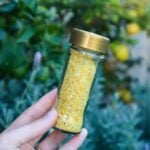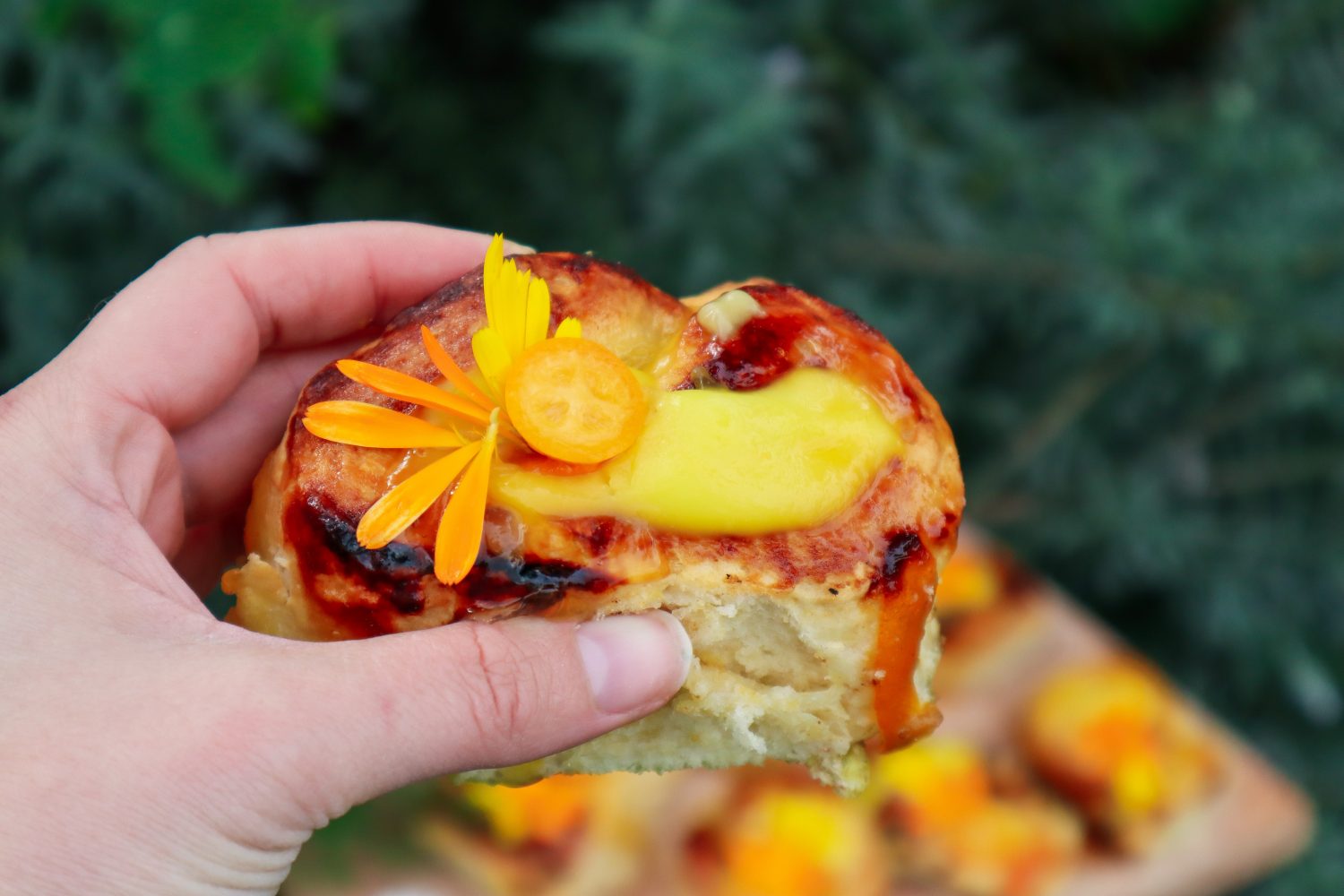Growing Sweet Potatoes / Kūmara (Ipomoea batatas) in your home garden is a great step toward self-sufficiency. Sweet Potatoes are my favourite permaculture plant and are an easy crop to grow for beginner gardeners. It is important to grow plants that support and encourage other plants and beneficial insects in your garden. Creating a cohesive ecosystem that promotes the growth and success of your garden’s health and supports abundant harvests.
Many people do not know that the leaves of the sweet potato plant are also edible. This is most likely because the leaves provide no economical value in the mainstream food system and so they are discarded. Our learnt behaviours tend to come from what is around us but the key is to question things more often. Can I eat this? How do I cook this? We are very lucky to have so much knowledge available to us at the click of a button.
If you want to learn more from outside “the box” subscribe to my blog and let’s get into all things, Sweet Potato!
WATCH my top 12 Reasons to start growing Sweet Potatoes or scroll down to read more.

12 Reasons to Grow Sweet Potatoes
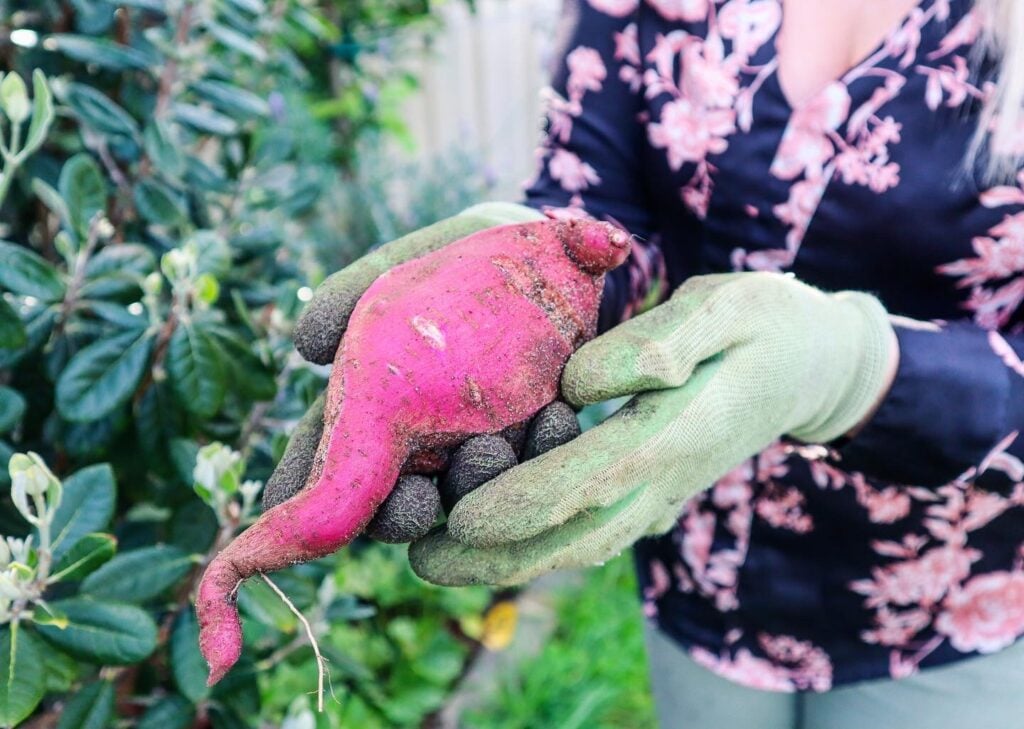
1. The Whole Plant is Edible
Not only does the Sweet Potato plant produce delicious edible tubers underground but, you can also eat the leaves and stems of the plant too ( It rarely flowers but these are not edible). Sweet Potato is not actually part of the potato family but is part of the morning glory family. Unlike potatoes – the sweet potato leaves are edible and packed full of *vitamin A, C, K, B1, B2, B3 and B9. Sweet potato leaves also have minerals such as calcium, iron, magnesium, phosphorus and potassium. Sweet potato leaves are used in a similar way to spinach. The young leaves and shoots can be added fresh to salads and smoothies or to curries, stirfries and soups. They can also be sauteed to make a delicious side dish of greens. Sautee in butter and garlic or tamari, garlic, chilli and ginger is another delicious way to use sweet potato leaves.
2. Produces an Abundant Crop on each Plant
Sweet potatoes produce many large tubers underground from a single plant. These tubers are high in calories and carbohydrates which can form a great “base crop” on your journey to living more self-sufficiently. Growing base crops such as sweet potatoes or pumpkin can increase your ability to make wholesome meals entirely from the garden. You can store sweet potatoes by letting them harden off for half to a whole day in sunlight or diffused sunlight. Then store them somewhere dark and cool for a few weeks or up to a few months. They will keep until they start sprouting or start to go soft and spongy. It can be a good idea to make meals from them and freeze them to preserve your harvests that way. Curried sweet potato soup is one of my favourite ways to prepare and save my sweet potatoes.
3. Grows Quickly and Easily
Sweet potatoes like warm weather and once the soil warms up in spring and summer they will take off and grow vigorously. They are a very low-maintenance plant that can still produce well with neglect. They can handle low water or dry spells but will produce best when kept well watered. They require free-draining soil as wet, boggy or heavy clay soils may cause the tubers to rot. Promote healthy, free-draining soil with lots of compost. The leaves may get holes and be eaten by bugs but they are very hardy and it would take a lot to restrict their growth. Sweet potato is fairly pest resistant but as the tubers form they will get closer to the surface of the soil. If they are exposed to the surface, rodents such as rats and mice may find them. Check that you can’t see any above the soil and if so, rebury them.
4. Can be Grown all Year Round
In warm climates with mild winters like we have here (Perth, Australia), Sweet potatoes can be grown all year round. It slows down in winter but you can still harvest the leaves. I have found the purple varieties grow best during winter. In cooler climates, it’s best to harvest your sweet potato before the winter sets in and grow it annually. You can, however, take cuttings and grow them indoors in jars of water or pot them up and have lush house plants over winter. Once Spring arrives and the soil warms up you can replant them back out into the garden. To get the most out of your tuber harvests it is best to harvest annually and then replant your patch. You can leave some tubers in the ground and they will remain dormant until the soil warms up and they will just pop and regrow by themselves!
5. You can Harvest in Stages
If you have a large sweet potato patch and multiple plants you can harvest your sweet potatoes in stages to get the most out of your harvests. When veggies are ready all at once it can be hard to utilise them and not get overwhelmed. Towards the end of summer and autumn, I will also just go out and harvest one or two for dinner. Here in Australia, we call it “bandicooting”. Bandicoots are marsupials that look kind of rat/rabbit-like, that fossick around for food. Find where the main stem of your sweet potato goes into the ground and have a light dig around to see if you can find any sweet potatoes near the surface.
6. Easy to Propagate
Propagating and growing more sweet potatoes is very easy and there are multiple ways to do this. If you do not already have sweet potatoes growing at home then you can start a patch with a single tuber from the farmers market. You can bury the whole tuber in the garden or cut it into 3-4 pieces and start multiple plants. Another way to grow a plant from the tuber is to place the tuber in a jar of water until it sends off shoots. The shoots can then be cut and placed in water to grow roots. Let the shoots get above 10cm before cutting them off. You can keep doing this and using your tuber to farm multiple plants.
Once you have an established patch you can cut sections of the vines off ( known as “slips” ) and regrow more plants. Either plant the slips directly into the soil or place them in a jar of water to form roots first. If you plant them directly into the garden make sure to keep them well watered while they strike roots.
To learn more about growing food from cuttings, check out my ebook. It’s a great way to establish an edible garden for little to no cost.

7. More Varieties Available
There are a lot more varieties of sweet potatoes than the ones you commonly see in the shops. Growing your own food opens up so many more exciting options and varieties of vegetables. The varieties available at the supermarket have been bred to aid in mass production, pest resistance and shelf life. Rather than on the quality of nutrients, texture and flavour. I know which ones I would pick! I am growing the Orange, Red and White, Hawaiian (white skin with purple flesh) and Purple skin with Purple flesh variety. They all have unique qualities and cooking properties. The Purple and White are deliciously roasted, whereas, the all-purple variety is not great roasted but delicious mashed. Once you have established some plants you can then swap and trade with others who may be growing different varieties to you.


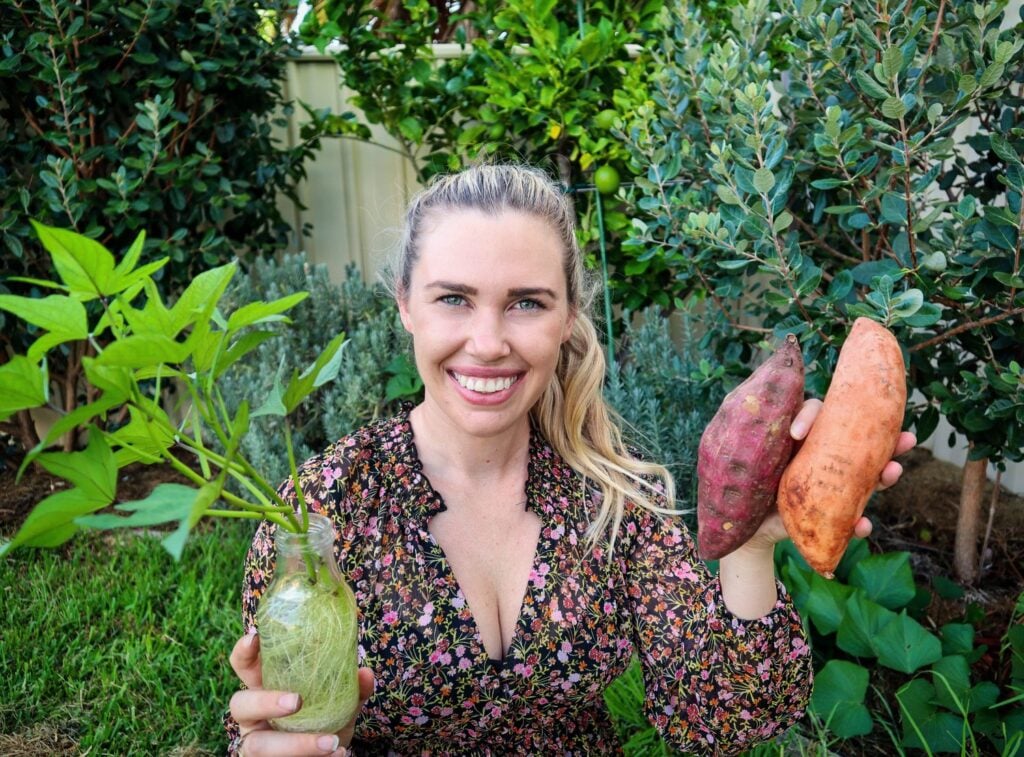
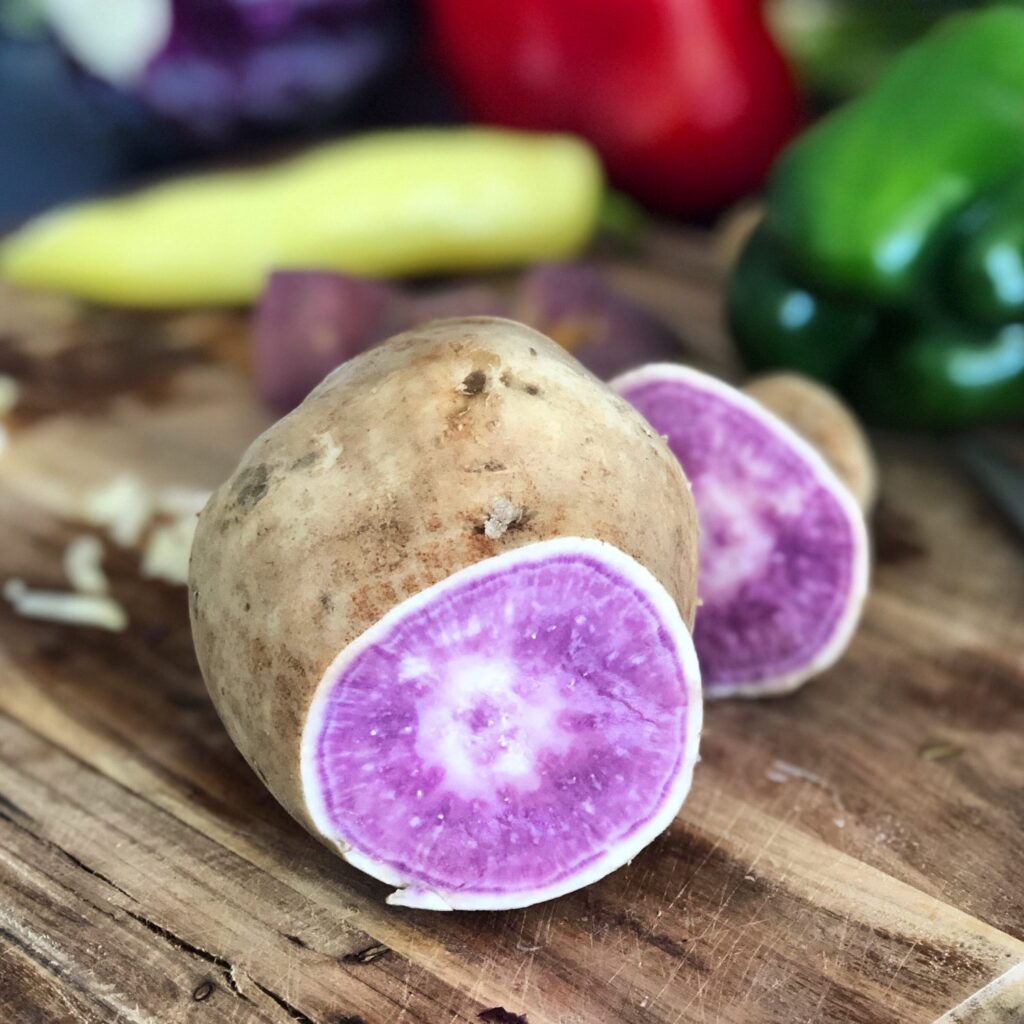
8. Amazing Living Mulch/ Ground Cover
The Sweet Potato naturally grows as a vine along the ground. It will send off side shoots and quickly become a thick and lush ground cover. This protects the soil from the harsh sun and creates a healthy habitat for beneficial insects. Having lots of beneficial insects is an essential part of growing a natural, thriving garden. This lush ground cover provides an excellent bottom layer of a food forest system. I have Sweet Potato vines growing all in between and underneath my fruit trees.
9. Grows in Sun or Shade
Sweet Potato prefers full sun but will grow in a wide range of locations from full sun to full shade. The plants that grow in shade will be slower to produce but will still grow well. This means you have more options in choosing a location to grow your Sweet Potato. I actually find that during our harsh summers in Perth, my Sweet Potato prefers some shade. Versatile plants are great for the garden because you have more flexibility and options for choosing a location to plant them. It also means they are a little more forgiving for beginner gardeners because they won’t up and die if the sunlight isn’t just right.
10. Grows in Containers or in the Garden
Urban gardens often mean utilising container gardens and selecting plants that grow in both is amazing! Ok, you can see why I love this plant! It is just so easygoing. The Sweet Potato plant can take off quickly and grow very vigorously. This means it can shade out smaller plants and take over the garden. If you are short on space or have small space, or urban gardens, then it may be best to grow it in containers. Don’t be afraid to cut off the edges if it starts to take over.
11. Can be Fed to Animals
Sweet Potato leaves can be feed to many animals including chickens, pigs and rabbits. When you are harvesting the patch or just trimming the edges, then this can be a great way to add feed to your animals. They are full of vitamins and nutrients to help boost your animal’s overall health. Plus, it promotes a sustainable cycle and the animal manure can then be composted to use on your gardens and grow more Sweet Potatoes!
12. Save Money!
Sweet Potatoes can be expensive! Especially if they are not the common variety. Recently the Red and White ones were over $9 p/k at my local store. With their ease of growth and abundant production, Sweet Potato is such an economical plant to grow in your home garden.
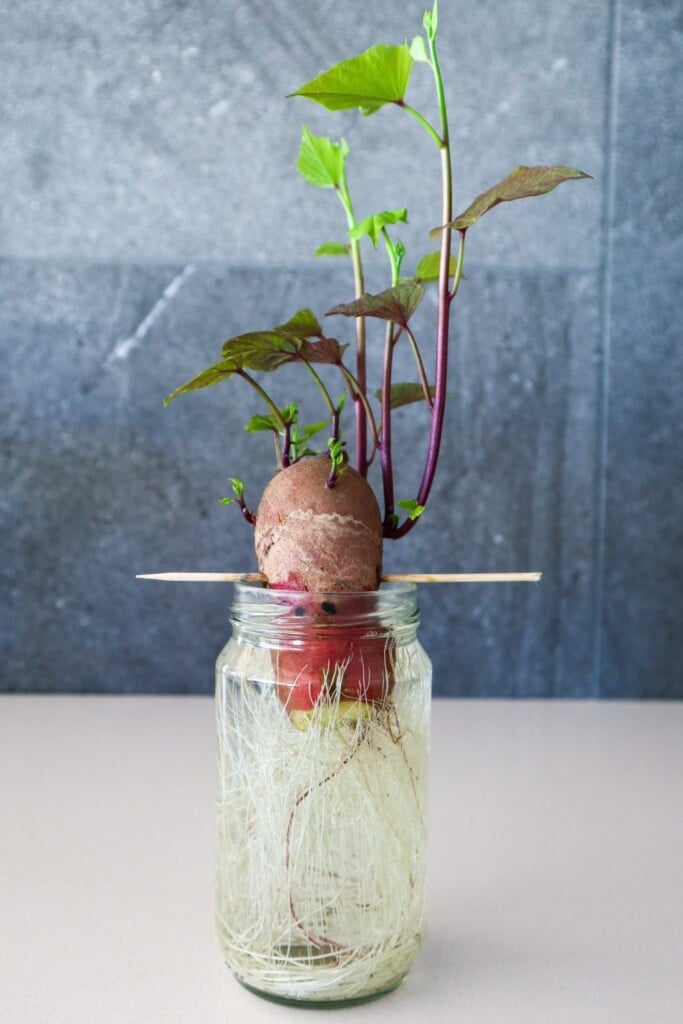
As you can see I could talk about growing sweet potatoes all day! They are my favourite permaculture plant because they are versatile and have so many benefits and interconnected relationships within the garden.
If you have any questions about growing, harvesting or propagating sweet potatoes please leave me a comment below. If you found this content helpful please share it with your friends. Sharing my articles will help me inspire and help more people to start growing their own food. Every little bit counts towards growing and inspiring a greener world.
Holly 🌱
*Macro nutrient reference: https://horticulture.ucdavis.edu/information/sweet-potato-leaves-family-nutrition-overview-research
DISCLAIMER: Links included on this page might be affiliate links. If you purchase a product or service with the links that I provide I may receive a small commission. There is no additional charge to you! Thank you for supporting my blog so I can continue to provide you with free content each week.
Subscribe
MY GARDENING ESSENTIALS //
Fertiliser spray gun: https://bit.ly/366nL1t
Retractable Hose: https://bit.ly/2TSC0Bo
More gardening tools: https://bit.ly/32IQmbD
DISCLAIMER: Links included in this description might be affiliate links. If you purchase a product or service with the links that I provide I may receive a small commission. There is no additional charge to you! Thank you for supporting my page so I can continue to provide you with free content!

